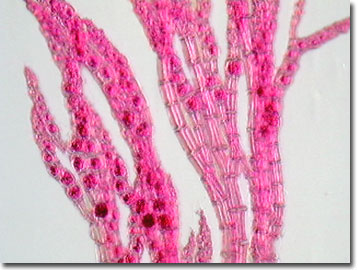Oblique Digital Image Gallery
Polysiphonia Red Algae
While there are more than 4,000 catalogued species of red algae worldwide, most are found in tropical marine waters, and only a few are freshwater species. Polysiphonia, a common genus of marine red algae, is red in color because of the pigment phycobilin, which masks the green color of the chlorophyll responsible for photosynthesis. As a red-colored plant, Polysiphonia is well suited to absorb the green and blue-green light that typically penetrates the deeper sea water where these red algae thrive.

View a second image of a Polysiphonia red alga.
Tough customers, fragments of red algae that survive the winter, or are buried under sand for months, can grow again into healthy plants under favorable environmental conditions. Red algae often attach to submerged stones or anchor to other marine plants and are able to withstand the wave and tidal forces of the intertidal zone.
Valued as a food plant, Polysiphonia retain their red coloring and gelatinous form, even when heated. These red algae are often used as vegetable substitutes for gelatin in puddings, ice cream, and toothpaste. As its generic name implies, Polysiphonia forms many "pipes" or branches in its typical configuration. Branch-like structures consist of a line of elongated cells that display a segmented appearance and produce secondary branches that radiate from the algae body. Long hairs known as trichoblasts are often observed growing from the branches.
Sexual reproduction is complicated and commands its own lexicon of terms to describe the numerous red algae life stages or phases. The tetrasporophyte is a small Polysiphonia plant with the diploid number (2N) of chromosomes. Round balls, or tetrasporangia, form on each segment and are easily seen on the branches. Dividing into four parts, the tetrasporangia form four haploid (N) spores that develop into the male and female plants or gametophytes. Nonflagellated spermatia are released to the water currents from the spermatangia formed on the top branches of the gametophyte. The spermatium moves to the carpogonium, the female reproductive organ, and they merge. Through a tube of the trichogyne, a hair-like receptive protuberance of the carpogonium, the nucleus of the male cells moves towards the egg cell, creating a zygote that develops into a cystocarp. In the cystocarp, diploid carpospores (2N) form and escape through a hole, eventually growing into new tetrasporophytes.
Contributing Authors
Cynthia D. Kelly, Thomas J. Fellers and Michael W. Davidson - National High Magnetic Field Laboratory, 1800 East Paul Dirac Dr., The Florida State University, Tallahassee, Florida, 32310.
BACK TO THE OBLIQUE IMAGE GALLERY
BACK TO THE DIGITAL IMAGE GALLERIES
Questions or comments? Send us an email.
© 1995-2025 by Michael W. Davidson and The Florida State University. All Rights Reserved. No images, graphics, software, scripts, or applets may be reproduced or used in any manner without permission from the copyright holders. Use of this website means you agree to all of the Legal Terms and Conditions set forth by the owners.
This website is maintained by our
Graphics & Web Programming Team
in collaboration with Optical Microscopy at the
National High Magnetic Field Laboratory.
Last Modification Friday, Nov 13, 2015 at 01:19 PM
Access Count Since September 17, 2002: 10471
Visit the website of our partner in introductory microscopy education:
|
|
